Analogy and Scientific Thought
May 9, 2016
According to a now discredited notion, the operating mode of
scientists is fixed by whether they are
right-brained, or
left-brained. Early
scientific studies seemed to indicate that the brain's
right hemisphere is the seat of
intuition and
creativity, while the brain's
left hemisphere is focused on
logic and problem solving. Thus, according to
Kuhn's dichotomy, the left-brained scientists practice
"normal" science, while the right-brained scientists are the
paradigm shifters.
This concept of functional brain
asymmetry began with observations that damage to the left side of the brain caused difficulty in understanding
language, while damage to the right side of the brain impaired
spatial ability.
Modern brain studies that now use
functional neuroimaging techniques have shown that this view of brain function is too simplistic. All parts of the brain "light-up" in different
thought processes, although some parts more than others. What still remains valid is that the right side of the body is controlled by the left hemisphere, and
vice versa.[1]
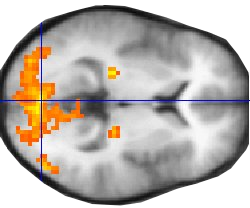
A functional magnetic resonance image showing brain regions activated when viewing a moving visual stimulus.
(Image by Washington irving, via Wikimedia Commons.)
When reviewing the
history of science, it's apparent that many scientific
theories were based on
analogy with the observed properties of other systems. As
Ralph Waldo Emerson said in his 1837 speech,
The American Scholar, "... science is nothing but the finding of analogy, identity, in the most remote parts."[2] The
Bohr model of the
atom resembles a miniature
solar system for the simple reason that
physicists at that time believed that both systems involved bodies under the influence of the same
inverse-square law attractive force.
Another example is the analogy between
electrical circuits and
hydraulics, as shown in the figure. It's likely that the
hydraulic analogy helped to conceptualize the development of some important
circuit theory concepts, such as
Kirchoff's law. Now, the analogy remains as a
teaching aid.
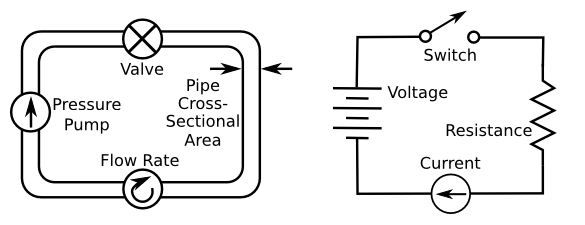
The hydraulic analogy of electrical circuits. In this analogy, voltage is associated with pressure, current with fluid flow, and resistance with the flow restriction caused by small diameter pipes. (Created using Inkscape.)
When a
biologist tests a
drug or potentially
toxic chemical on a
mouse with the idea that he will obtain information relevant to the affect of that substance on a
human, he's performing what
philosophers call an
argument from analogy. Since mice survive by essentially the same
physiological processes as humans, it's expected that there will also be a commonality in the
organism's reaction to this new substance. Unfortunately, there are sometimes problems with this approach, as shown by
phocomelia associated with
thalidomide.
Mathematics allows us to quantify observations, but mathematical concepts are used also as analogy to guide
research. There's no real reason, as far as we know, why a mathematical prediction should lead to an observation, but it often does. For example, a certain
symmetry of
subatomic particles caused physicists to believe that a missing particle, the
Omega-minus (Ω-) particle, should exist, and it was discovered in 1964 (see figure).
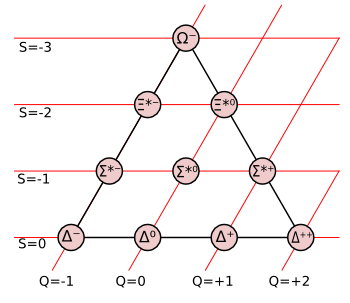
A baryon decuplet of Delta (Δ), Sigma (Σ), Xi (Ξ), and Omega (Ω) baryons.
In this illustration, Q is electric charge and S is strangeness.
(Modified Wikimedia Commons image.)
Johannes Kepler, best known for deducing the
laws of planetary motion, was an ardent practitioner of analogy who's quoted as saying, "...I especially love analogies, my most faithful masters, acquainted with all the secrets of nature."[3] In his
Harmonices Mundi, Kepler attempted to justify an ancient idea, called
musica universalis, that expresses an analogy between the
harmony of
planetary movement and
musical harmony.

A figure on page 47 of Book III of Johannes Kepler's Harmonices Mundi. (PDF text via Wikimedia Commons.[4]
Kepler also explained the motion of the planets by analogy to the motion of a
ship in a
current of water, with the
Sun generating some sort of
circular river.[5] He had a further
magnetism analogy in which the
Earth was like a lump of
iron influenced by a magnetic Sun.[5] He was surprisingly close to the mark by having an iron Earth.
Sadi Carnot, in his
Reflections on the Motive Power of Fire, made an analogy between water falling through a
waterfall and
heat, his
caloric fluid, "falling" through a
heat engine.[3]
Robert Boyle, known especially for
Boyle's law, justified his idea that many small
particles can combine to have a large affect with an analogy to the ability of a
swarm of
ants to move large objects.[3]
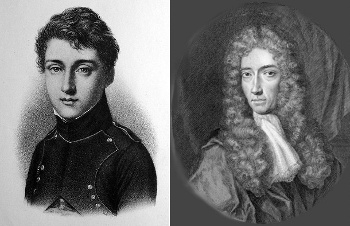
Sadi Carnot (left) and Robert Boyle (right)
(Carnot image, and Boyle image, via Wikimedia Commons.)
Alchemy, the root of modern
chemistry, had the strange analogy that the
alloying of two component
metals was like a
marriage. The
alchemists ascribed
maleness to such
elements as
mercury, and
femaleness to
sulfur.[3]
Psychologist and
philosopher,
William James, thought that reasoning by analogy was a part of
human nature. As he wrote in his 1890
book,
The Principles of Psychology, "Men, taken
historically, reason by analogy long before they have learned to reason by
abstract characters."[6]
William James may just have been proven correct more than a
century after he penned this
conjecture. Scientists from
Carnegie-Mellon University (CMU) have just shown that the concept of analogy in science runs far deeper than our use of one scientific observation to describe another. Such analogy in the service of science appears to be
hardwired into the brain.[7]
Robert Mason and
Marcel Just of CMU used functional magnetic resonance imaging on nine advanced physics and
engineering student to show that the brain centers used for such early human tasks such as
hunting,
foraging, and
survival, are re-purposed to understand such abstract concepts as
momentum,
energy and
gravity. More specifically, the brain is able to learn physics concepts because of its ability to understand the four fundamental concepts of
causal motion,
periodicity,
energy flow, and
sentences describing quantities.
They suggest that this finding might be useful in
science education, since it suggests to
teachers better ways to teach these abstract scientific concepts. Says Mason, a senior
research associate in
CMU's Department of Psychology,
"If science teachers know how the brain is going to encode a new science concept, then they can define and elaborate that concept in ways that match the encoding. They can teach to the brain by using the brain's language."
In the
experiments, the brain of each student was scanned while they were shown a set of thirty concepts familiar to scientists and engineers, such as
inertia,
velocity, gravity,
entropy, and
refraction. It was found, for example, that the brain regions excited while hearing the steady
gallop of a
horse were the same that were excited while contemplating
the mechanics of waves. Likewise regions that would have been excited when
Newton saw his
apple fall are the ones involved with the abstract physical concept of gravity.
The concept of energy flow was found to have a commonality to sensing warmth from the Sun or other heat source. Perusing mathematical
equations evokes the same brain systems used to comprehend sentences that described quantities. Says co-author of the study and CMU
professor, Marcel Just,
"This is why humans have been able to move ahead and innovate -- because we can use our brain for new purposes... Human brains haven't changed much over a few thousand years, but new fields like aeronautics, genetics, medicine and computer science have been developed and continuously change. Our findings explain how the brain is able to learn and discover new types of concepts."
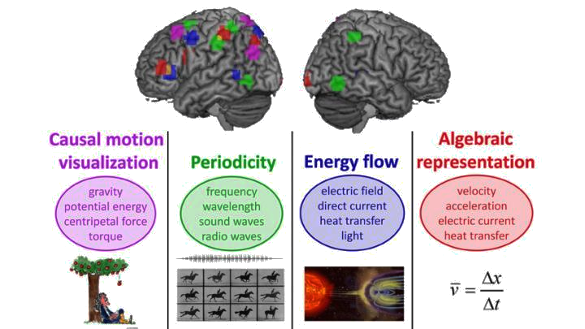
Functional magnetic resonance imaging of brain regions activated by certain concepts in physics. The brain is able to learn physics concepts since they relate to the everyday ideas of causal motion, periodicity, energy flow and sentence-like structure. This research was funded by the Office of Naval Research. (Carnegie Mellon University image.)
References:
- Tania Lombrozo, "The Truth About The Left Brain / Right Brain Relationship," NPR, December 2, 2013.
- Ralph Waldo Emerson, "The American Scholar," 1837, via Hanover College Web Site.
- Dedre Gentner and Michael Jeziorski, "The shift from metaphor to analogy in Western science," From Metaphor and Thought, Andrew Ortony, Ed. (Cambridge University Press, 1993), ISBN:9780521405614, pp. 447-480 (2 MB PDF File).
- Johannes Kepler, "Harmonices Mundi," 1619, Latin Text via Archive.org (24 MB PDF file).
- Dedre Gentner, Sarah Brem, Ron Ferguson, Philip Wolff, Arthur B. Markman, and Ken Forbus, "Analogy and creativity in the works of Johannes Kepler,"In T. B. Ward, S. M. Smith, and J. Vaid, Eds., "Creative thought: An investigation of conceptual structures and processes," American Psychological Association (Washington, DC, 1997), pp. 403-459.
- William James, "The Principles of Psychology," Vol. II, Henry Holt and Company (New York, 1905), p. 363, via Archive.org.
- Scientists discover how the brain repurposes itself to learn scientific concepts, Carnegie Mellon University Press Release, April 12, 2016. A preprint of this study is available here (0.5 MB PDF file).
Permanent Link to this article
Linked Keywords: Scientist; lateralization of brain function; right-brained; left-brained; scientific; cerebral hemisphere; right hemisphere; intuition; creativity; left hemisphere; logic; Thomas Kuhn; dichotomy; "normal" science; paradigm shift; asymmetry; language; spatial visualization ability; functional neuroimaging; thought processes; functional magnetic resonance imaging; visual perception; stimulus; Wikimedia Commons; history of science; theory; analogy; Ralph Waldo Emerson; The American Scholar; Bohr model; atom; solar system; physicist; inverse-square law; attractive force; electrical circuit; hydraulics; hydraulic analogy; circuit theory; Kirchoff's law; pedagogy; teaching aid; voltage; pressure; electric current; fluid dynamics; fluid flow; electrical resistance; diameter; pipe; Inkscape; biologist; pharmaceutical drug; toxicity; toxic chemical; mouse; human; philosopher; argument from analogy; physiology; organism; phocomelia; thalidomide; mathematics; research; symmetry; subatomic particle; Omega-minus (Ω-) particle; Eightfold Way; baryon decuplet; Delta baryon (Δ); Sigma baryon (Σ); Xi baryon (Ξ); Omega baryon (Ω); baryon; electric charge; strangeness; Wikimedia Commons; Johannes Kepler; Kepler's laws of planetary motion; Harmonices Mundi; musica universalis; harmony; planetary movement; musical harmony; ship; current of water; Sun; circle; circular; magnetism; Earth; iron; Sadi Carnot; Reflections on the Motive Power of Fire; waterfall; heat; caloric theory; caloric fluid; heat engine; Robert Boyle; Boyle's law; particle; swarm behavior; ant; alchemy; chemistry; alloy; alloying; metal; marriage; alchemist; male; maleness; chemical element; mercury; female; femaleness; sulfur; psychologist; philosopher; William James; human nature; book; The Principles of Psychology; history; historical; abstraction; abstract character; century; conjecture; Carnegie-Mellon University; hardwired; Robert Mason; Marcel Just; engineering; student; hunting; foraging; survival; momentum; energy; gravitation; gravity; causality; causal; motion; periodic function; periodicity; energy transfer; energy flow; sentence; linguistics; science education; teacher; research associate; CMU Department of Psychology; experiment; inertia; velocity; entropy; refraction; gallop; horse; mechanics of waves; Isaac Newton; apple; equation; professor; innovation; innovate; aeronautics; genetics; medicine; computer science; Office of Naval Research.